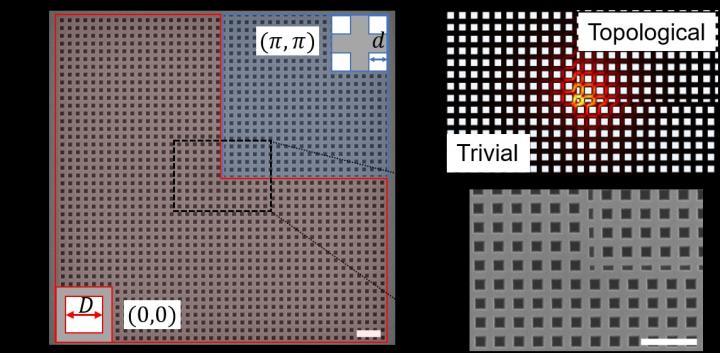Jul 7 2020
In the past, researchers have extensively analyzed the applications of topological photonics, such as topological lasers and one-way waveguide.
 (a) Scanning electron microscopy image of a fabricated 2D topological photonic crystal cavity in a square shape. The inset on the right shows an enlarged image around the corner. The scale bar is 1 μm. The topological nanocavity consists of two topologically distinct photonic crystals, which are indicated by the red and blue areas. They have different unit cells, as shown in the insets. d and D are the lengths of the squares in the blue and red unit cells, in which D = 2d. (b) Electric field profile of the topological corner state. Image Credit: Weixuan Zhang, Xin Xie, Huiming Hao, Jianchen Dang, Shan Xiao, Shushu Shi, Haiqiao Ni, Zhichuan Niu, Can Wang, Kuijuan Jin, Xiangdong Zhang, and Xiulai Xu.
(a) Scanning electron microscopy image of a fabricated 2D topological photonic crystal cavity in a square shape. The inset on the right shows an enlarged image around the corner. The scale bar is 1 μm. The topological nanocavity consists of two topologically distinct photonic crystals, which are indicated by the red and blue areas. They have different unit cells, as shown in the insets. d and D are the lengths of the squares in the blue and red unit cells, in which D = 2d. (b) Electric field profile of the topological corner state. Image Credit: Weixuan Zhang, Xin Xie, Huiming Hao, Jianchen Dang, Shan Xiao, Shushu Shi, Haiqiao Ni, Zhichuan Niu, Can Wang, Kuijuan Jin, Xiangdong Zhang, and Xiulai Xu.
In particular, topological lasers have gained wider attention in the recent past. They have been proposed and demonstrated in different systems, such as 0D boundary state in 1D lattice, 1D edge state in 2D systems, and topological bulk state around band edge. A majority of them are found at the microscale.
Researchers are yet to explore topological nanolasers with low threshold, compact footprint, and high energy efficiency. A research team recently proposed and demonstrated a new kind of higher-order topological insulators with a lower-dimensional boundary state in many systems, such as 2D photonic crystals.
Gapped 1D edge states and mid-gap 0D corner states occur in the second-order 2D topological photonic crystal slab. This localized corner state offers a novel platform to achieve topological nanolasers.
In a new study reported in Light: Science & Applications, the research team, under the guidance of Professor Xiulai Xu from Beijing National Laboratory for Condensed Matter Physics, Institute of Physics, Chinese Academy of Sciences, China, and collaborators have realized a low-threshold topological nanolaser in 2D topological photonic crystal nanocavity.
A topological nanocavity is designed and developed based on the second-order corner state. The quality factor (Q) is further improved using a theoretical maximum of 50,000. It has been shown that the corner state is robust against defects in bulk photonic crystal.
The team observed a lasing behavior with high spontaneous emission coupling factor (β) and low threshold. The performance was comparable to that of traditional semiconductor lasers. This suggests there is immense potential for its use in an extensive array of applications for topological nanophotonic circuitry.
The topological nanocavity is formed of two types of photonic crystal structure with a common bandstructure but different topologies characterized by 2D Zak phase. In the bulk-edge-corner correspondence, the quantized edge dipole polarization, which is highly localized at the intersection of two boundaries, induces the mid-gap 0D corner state.
The Q is improved with a smoother spatial distribution of corner state by tweaking the gap distance (g) between the nontrivial and trivial photonic crystal slabs.
The newly developed topological nanocavities that exhibit different parameters are incorporated into GaAs slabs with a high density of InGaAs quantum dots. The trend of Q with g is in good agreement with the theoretical estimation, where the values are almost one order of magnitude lower compared to the theoretical estimates, caused by imperfections in the fabrication.
The Q and the corner state’s resonance wavelength are vulnerable to disorder close to the corner. However, the bulk band’s nontrivial 2D Zak phases topologically protect the corner state, making it robust against the defects in bulk photonic crystal, which has been shown experimentally.
At 4.2 K, the team observed a lasing behavior with high performance, where quantum dots were used as the gain medium. β is around 0.25, and the lasing threshold is nearly 1 μW.
The performance is higher compared to that of topological edge lasers, specifically the threshold, which is nearly three orders of magnitude lower compared to a majority of the topological edge lasers. The high performance is the result of the strong optical confinement in the cavity induced by the high Q value and the small mode volume.
The outcomes of this study downscale the topological photonics applications to the nanoscale. This will be of immense relevance to the creation of topological nanophotonic circuitry.
Moreover, the topological nanocavity can considerably improve the interaction between light and matter, thus facilitating research into cavity quantum electrodynamics and the further prospective applications in topological nanophotonic devices.
Journal Reference:
Zhang, W., et al. (2020) Low-threshold topological nanolasers based on the second-order corner state. Light: Science & Applications. doi.org/10.1038/s41377-020-00352-1.